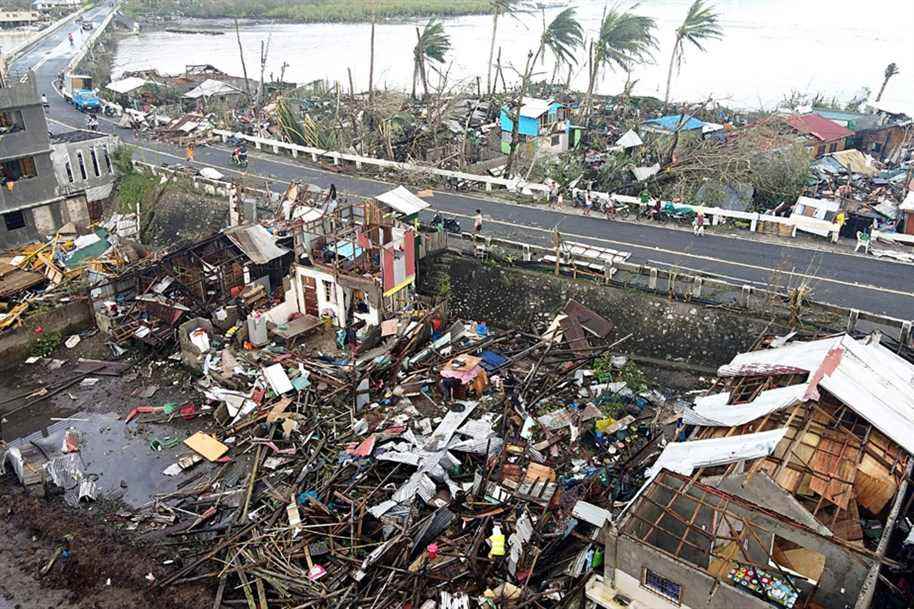(Surigao) At least 75 people were killed in the Philippines during the passage of Typhoon Rai, the most powerful to hit the country this year, according to official reports released Sunday.
At least 75 people have been killed in the Philippines during the passage of Typhoon Rai, the most powerful to hit the country this year, according to official reports released on Sunday.
The governor of the tourist island of Bohol (center), Arthur Yap, announced on his Facebook page that 49 people had died and 10 were missing in his province, according to data communicated by the mayors, bringing the death toll to 75 provisional total for the disaster.
“Communications are still cut. Only 21 mayors out of 48 got in touch with us, ”he said.
Rai was described as a “super-typhoon” when it made landfall Thursday, on the tourist island of Siargao, accompanied by winds of 195 km / h.
“Everything was flying, it was as if it was the end of the world,” Raphy Repdos, a tour operator visiting the island at the time of the storm, told AFP.

PHOTO MARCO J. DAGASUHAN, VIA REUTERS
Rai was described as a “superyphon” when it made landfall Thursday, on the tourist island of Siargao, accompanied by winds of 195 km / h.
More than 300,000 people have had to flee their homes since Thursday due to the typhoon that devastated the south and center of the country, according to the National Agency for Natural Disasters of the Philippines.
It crossed the northern popular tourist destination of Palawan Island in late Friday afternoon with winds of 155 km / h according to the National Meteorological Agency, before heading away towards the South China Sea. , in the direction of Vietnam.
Aerial photos shared by the military showed extensive damage in the town of General Luna, where many surfers and vacationers had flocked before Christmas, with buildings without roofs and debris littering the ground.
“Like paper”
The neighboring island of Dinagat was “wiped out” by the storm, Governor Arlene Bag-ao wrote on Facebook, adding that houses, boats and fields had been destroyed.
“The walls and roofs were ripped off and blown up by Odette like paper,” Bag-ao said, using the typhoon’s local name.
“Our food and water reserves are dwindling. Electricity and telecommunications are down, ”he added.
“This is one of the most powerful storms to hit the Philippines in December over the past decade,” Alberto Bocanegra, head of the International Federation of Societies of the Cross, told AFP. -Red and Red Crescent in the Philippines. “The information we receive and the images we receive are very alarming.”
More than 18,000 soldiers, police, coastguard and firefighters will join search and rescue efforts in the most affected regions, told AFP Mark Timbal, spokesman for the national disaster agency.
“There has been significant damage” in Surigao and Siargao, the areas that suffered the most from the typhoon, Mr. Timbal said.

PHOTO FERDINANDH CABRERA, FRANCE-PRESS AGENCY
Windows broke during the passage of Rai in Surigao City.
Siargao Island has around 100,000 inhabitants and attracts many surfers and passing vacationers.
The toll was increased after the announcement of the disaster manager of the central province of Negros Occidental, who confirmed the death of 13 people, most of them by drowning, and the disappearance of 50 others in an area affected by the floods.
“We started urging people to evacuate on Wednesday, but many were reluctant to leave,” Salvador Mesa told AFP.
Widespread destruction
On the island of Dinagat, where the typhoon killed six people in less than six months, residents “are trying to repair their homes because even our evacuation centers have been demolished” said the vice-governor of this eastern region. country Nilo Demerey on ABS-CBN TV channel.
“They cannot take refuge elsewhere… everything has been destroyed,” he lamented.
Bocanegra warned that the power cuts would affect the water supply, raising concerns about sanitary conditions.
Rai is a particularly late typhoon in the season. Most tropical cyclones in the Pacific Ocean form between July and October.
Scientists have long warned that typhoons are getting stronger and stronger as man-made global warming accelerates.
The Philippines, considered one of the countries most vulnerable to global warming, is struck each year by around 20 typhoons which often wreak havoc on homes, crops and infrastructure in already very poor regions.
The deadliest cyclone on record in the Philippines is the “super-typhoon” Haiyan, which left more than 7,300 dead or missing in 2013.
